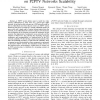Free Online Productivity Tools
i2Speak
i2Symbol
i2OCR
iTex2Img
iWeb2Print
iWeb2Shot
i2Type
iPdf2Split
iPdf2Merge
i2Bopomofo
i2Arabic
i2Style
i2Image
i2PDF
iLatex2Rtf
Sci2ools
INFOCOM
2009
IEEE
2009
IEEE
Impacts of Peer Characteristics on P2PTV Networks Scalability
ŌĆöA P2PTV system allows users to watch live video streams redistributed by other users via a peer-to-peer (P2P) network. In an ideal world, each peer in a P2P network would be able to redistribute more bytes than it receives. A P2PTV system built from such peers can support a virtually unlimited number of peers; with only a single copy of content stream injected into the network, it can redistribute the content to all peers. Two factors in the development of the Internet prevented the realization of this scenario: the deployment of asymmetric access networks and the adoption of NAT boxes. For real-time live streaming, such peer asymmetry and incompatibility is a limiting factor on the P2P network scalability. We ’¼ürst develop a basic formal analysis of the effect of bandwidth asymmetry on P2P network scalability. Then we present several characteristics of peer asymmetry as measured on the Zattoo P2PTV network. Our simulation results, driven by the measured peer characteristics, con’¼...
Related Content
| Added | 24 May 2010 |
| Updated | 24 May 2010 |
| Type | Conference |
| Year | 2009 |
| Where | INFOCOM |
| Authors | Khaldoon Shami, Damien Magoni, Hyunseok Chang, Wenjie Wang, Sugih Jamin |
Comments (0)

